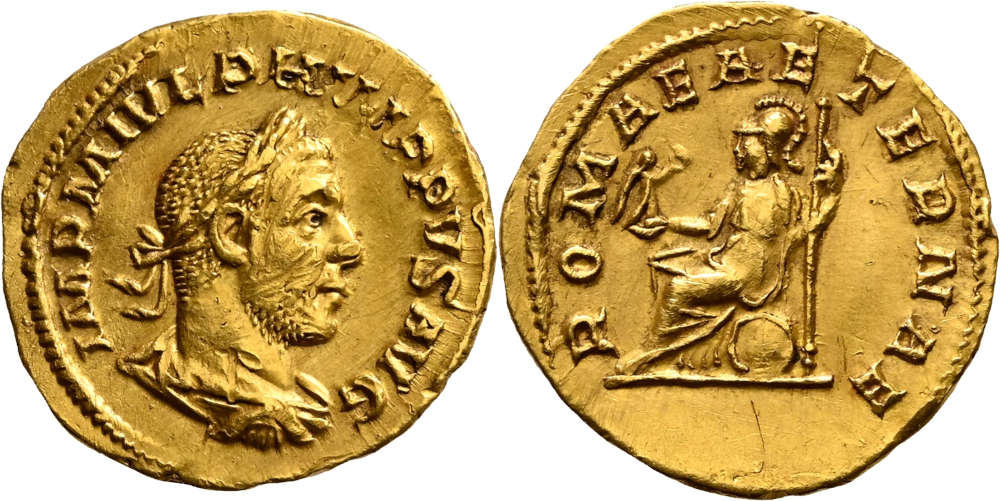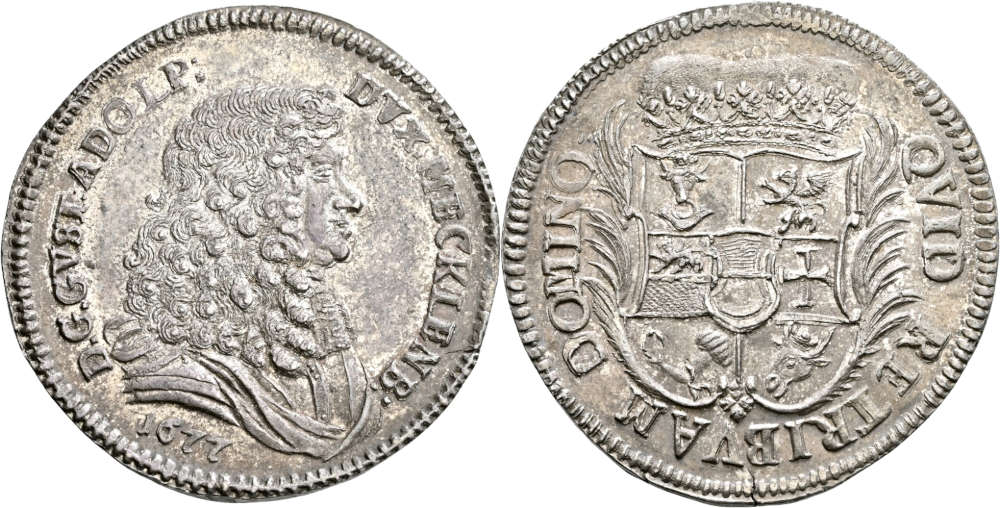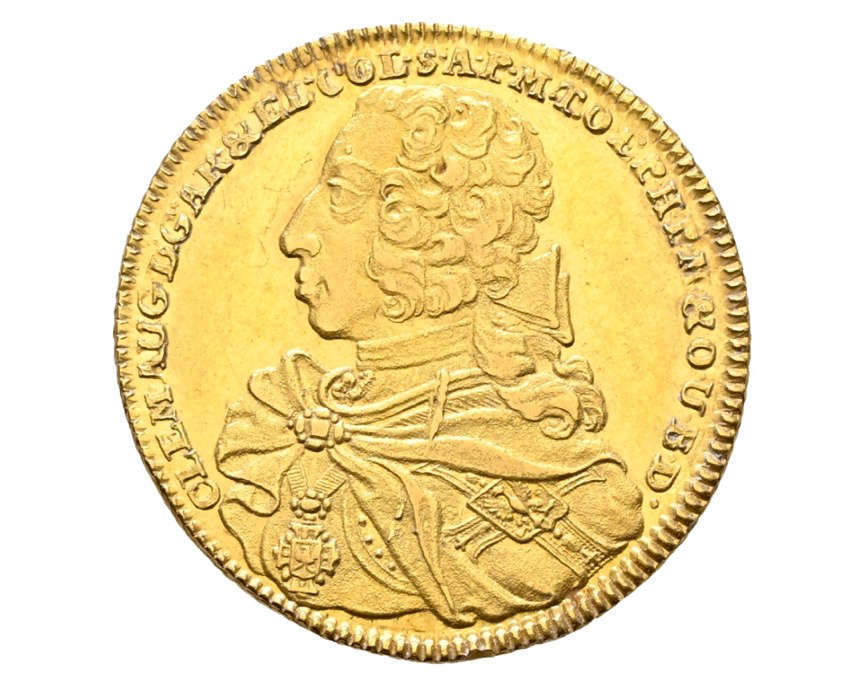Big Autumn Auction at Peus
Dr. Busso Peus Nachf.
Auction 439-441
Coins
4-7 November 2024
D-Frankfurt a.M.
All collectors and fellow dealers should make a note of this year’s autumn auction of Dr. Busso Peus Nachf. in their calendars now! The auction week begins on Monday, 4 November, an exception at Peus, and offers a particularly attractive selection of ancient coins. Several entire collections have been included in the 1250 individual lots, some of which we would like to highlight here.

Lot 548: Roman Imperial. Philippus I. Arabs (244-249). Aureus, 244/247, Rome. Fine toning. Very rare. Good very fine. Estimate: 12,500 EUR.
Ancient Coins
The Nummi Regnum Britonum (Coins of the Kingdoms of the Britons) collection focuses on the coinage of the ‘Celtic’ tribal chieftains of the British Isles. It was built up between the early 1990s and the late 2000s with a focus on gold coinage and contains numerous rarities, many of which have not been offered for sale for many years. Ancient British numismatics, with its florid and sometimes local patriotic type designations such as ‘Gisleham Glory’ and ‘Irstead Smiler’, is a cosmos all of its own, into which the Nummi Regnum Britonum collection provides a fascinating insight.
The particularly rich part of Greek coins in this auction consists in its core of specimens from the collection of Dr Hans Maag (1929-2009), which complement the holdings we were allowed to offer in our auction no. 407 in 2012. These coins harmonise wonderfully with a collection of smaller silver denominations (up to drachms) from a collector who wishes to remain anonymous and attaches particular importance to both quality and provenance. Once again, illustrious pedigrees such as ‘ex Coll. Hermitage’ (nos. 95 and 356) or ‘ex Metropolitan Museum’ (no. 313) as well as numerous provenances from the period before the Second World War can be found in our catalogue, which also boasts dozens of plate specimens. Further high-quality but smaller consignments, including some ‘latecomers’ from the Rudolf Hoesch Collection, ‘Hunting and Animals’, which was sold very successfully in Auction 438, round off the range of Greek coins on offer.
Anyone browsing through the section of Roman coins will notice that this auction features a particularly large number of Aes coins, especially sestertii, with a focus on the popular ‘philosopher emperor’ Marcus Aurelius. Most of these pieces come from the holdings of a deceased collector from the Rheingau region, comprising around 500 specimens, from which we were also able to create attractive and collector-friendly lots. The centrepiece, however, is a part of a large collection of often excellently preserved denarii from the middle price segment, supplemented by an opulent lot of late antique gold coins.
The special collection ‘de face’ concluding the ‘Antique Day’ of our auction 439 forms a separate catalogue section in order to highlight the special nature of the chosen collection theme. ‘De face’ is the elegant French technical term for frontal depictions, and so leafing through this collection – and especially the elaborately designed plates – offers a rare experience: from every catalogue page and from every single coin, faces gaze out at the viewer, be they those of gods, heroes, monsters or even crabs.

Lot 3021: German Coins after 1871. Duchy of Saxe-Coburg-Gotha. Ernst II (1844-1893). 20 Mark, 1872 E. Extremely rare, only 1,000 examples minted. Very fine. This is the rarest type of all imperial gold coins. Estimate: 50,000 EUR.
Medieval and Modern Coins
The range of medieval and modern coins on offer is so large that 3 days, from 5 to 7 November, must be planned for it.
After the usual coins and medals from all over the world and from the Habsburg hereditary lands, the collection of bracteates from a southern German collector will appear as a whole, ahead of the remaining coins from the old German states. Comprising over 180 lots, the collection represents the entire spectrum of bracteate coinage from central Germany to the mints around Lake Constance at low and medium price levels.
As usual, the coins and medals of the Feudal German states follow through all centuries, in all metals and in all price categories. Remarkable is the number of thalers before 1800, which are distributed alphabetically throughout the catalog.
With over 150 individual lots from the 13th century to 1866, the coins of the imperial city of Frankfurt are represented in particularly large numbers and high quality.
A collection of over 100 coins and medals from the County of Hanau up to the time of the Landgraviate of Hesse-Kassel must be mentioned, too. In particular, the numerous mining-thalers from the Bieber mines are worth a closer look.
Wednesday, November 6, belongs to German coins after 1871, and Dr. Busso Peus Nachf. is proud to offer an almost complete collection by years of gold coins from the German Empire as the highlight of the 439th auction. Among them are rarities such as the Bavarian 20 mark piece of the 1913 vintage year (J. 200) in outstanding condition, the Mecklenburg-Strelitz 10 mark piece of 1873 (J. 235) or the extremely rare 1877 vintage year of the Saxon 20 mark piece (J. 262). The highlight is the rarest type of all imperial gold coins: Saxe-Coburg-Gotha, 20 marks 1872 (J. 3021).
As usual with Peus, this closed collection is followed by the coins of the German Empire in gold and silver, the Weimar Republic and other areas from various owners. Here, too, some rarities can be found.
Paper money with rare banknotes of the high inflation, the Weimar Republic and the world wars, as well as numismatic literature follow.
As always, the traditional conclusion is formed by numerous favorably priced lots from all over the world and from all periods.
Thursday, November 7, still has 2 collections in store, each of which deserves its own hardcover auction catalog due to its size and importance.

Lot 4068: Old Germany. Duchy of Mecklenburg-Güstrow. Gustav Adolph (1639-1695). Imperial thaler 1677, Güstrow. Fine patina. Extremely rare. Extremely fine/mint state. Estimate: 15,000 EUR.)
Auction 440: The Collection Mecklenburg
ranges from the late Middle Ages to the loss of minting rights in 1918, with the Güstrow, Schwerin and Strelitz lines boasting 270 items and numerous rarities. In addition to the spectacular gold coins, talers and partial talers, small denominations and medals are not neglected. Both the specialist collector of Mecklenburg coins and the tasteful universal collector in search of selected rarities will find what they are looking for here.

Lot 5574: Old Germany. Archbishopric of Cologne. Clemens August of Bavaria (1723-1761). Caroline 1735, Bonn. Extremely rare. Extremely fine. Estimated price: 10,000 EUR.
Auction 441: The Hermann-Joseph Lückger Collection – Rhineland and Westphalia
Or why Cologne once again? Exactly one year ago, Dr. Busso Peus Nachf. was fortunate enough to auction the largest collection of Cologne coins and medals of recent decades, the Dr. Jürgen Baur Collection. Now, with the Lückger Collection, it is offering a similar but fundamentally different collection on the subject of the Rhineland and Westphalia. However, it is not a mere 2nd edition to please the underbidders of last time, but an excellent addition to it. The focus of the Lückger Collection is on coins from the Middle Ages and, it can be said, is unparalleled in its size. The times made it possible for well-connected, passionate and affluent collectors to assemble collections of a quantity and quality that is almost unimaginable today. The Baur Collection focused on the city and archbishopric of Cologne, including its dynastic and political contexts. In doing so, it partly left geographical proximity behind. Lückger’s collection, being an outstanding historian and archaeologist, was primarily dedicated to the medieval coinage of Cologne’s neighbors in the economic area, so that we find coins from the Netherlands to Hesse, Westphalia to Mainz and Trier in a closed density. It is a collection that also offers many rarities and curiosities to collectors not connected with Cologne. There is not enough space here to list them all; to pick out individual ones would be arbitrary. But of course, there are also coins and medals from modern times up to the 19th century. See for yourself in the special catalog, which is also of interest to the academic community.





